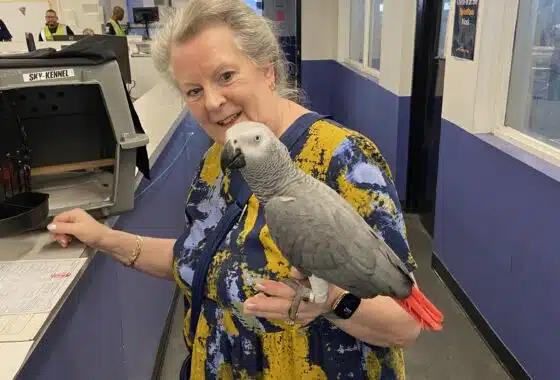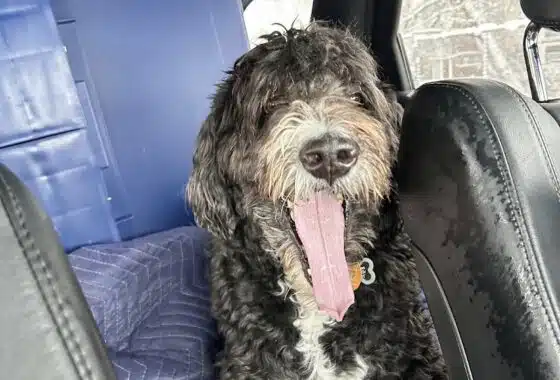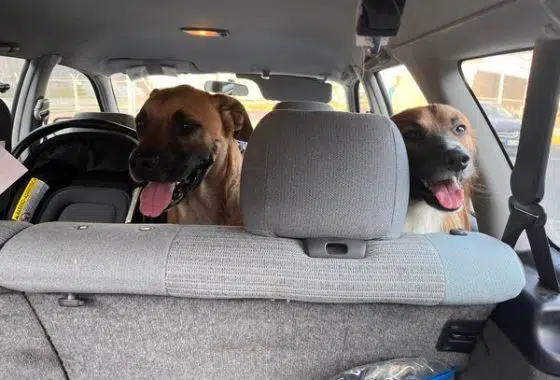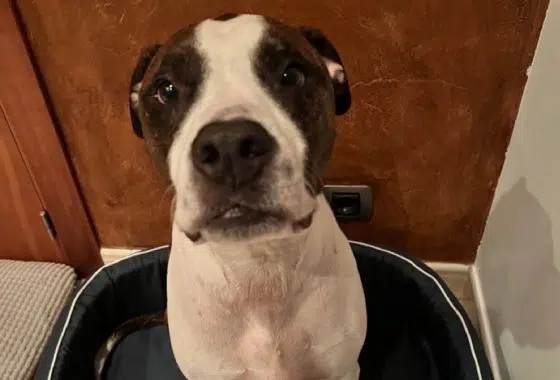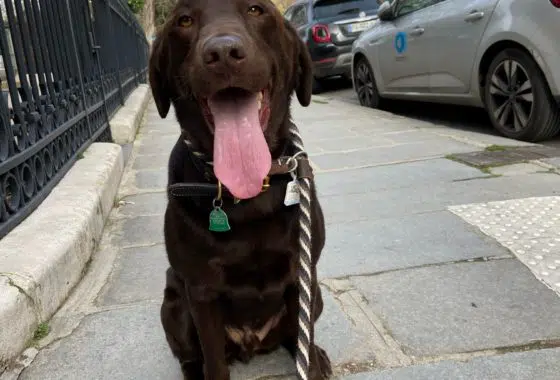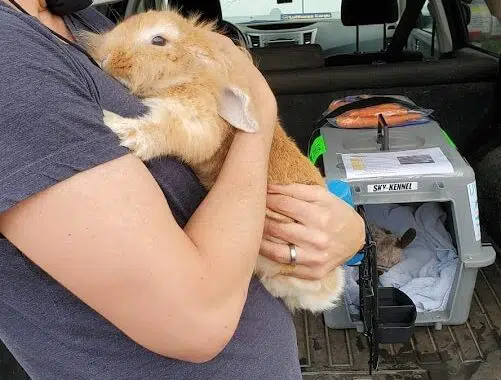
INTERNATIONAL PET SHIPPING
How Safe is Air Travel For Pets?

Pet Safety during Air Travel
Ever wondered about the safety of transporting pets in the cargo hold of an airplane? In the industry, this is commonly referred to as cargo transportation, and rest assured, it’s much safer than you might imagine!
In this article, we address common concerns about airline pet travel and highlight the strategies we employ to ensure the utmost safety for your furry or feathered companion.

Are the holds pressure and temperature controlled?
The short answer is yes, the pet hold is temperature and pressure-controlled. The International Air Transport Association’s Live Animals Regulation (IATA LAR) governs the rules for transporting pets. These regulations set the standard for pet transportation, ensuring that our furry, feathered, or scaled friends travel safely. While airlines have the liberty to enhance rules for the better, they cannot compromise on the established standards without facing penalties, including fines or even temporary suspension of live animal services. This underscores the importance of choosing an airline that not only adheres to these guidelines but also places a high value on pet safety. Pet shipping companies can be a great resource in determining the best airline for the desired route, as they are aware of each airline’s protocols and processes.
When it comes to the actual transportation, not all aircraft are equipped to handle our beloved companions. For a pet to be allowed onboard, the aircraft must maintain a portion of the cargo hold within a temperature range of 7.2°C (45°F) to 29.5°C (85°F). While this technology is common on passenger flights, it’s crucial to note that only certain sections of the hold are designed to sustain the ideal pressure and temperature conditions necessary for pet travel. Moreover, the presence of incompatible items or other types of animals might further limit the availability of suitable flights, making the process even more challenging. If the cargo hold air conditioning system malfunctions during inspection, all pets must be rebooked!
Risks and Mitigation
Pet relocation by air cargo can introduce various risks, with the most critical moments occurring during the transit from the terminal to the aircraft, and while waiting to be loaded and unloaded. Picture the scorching heat of a summer day, a pet enclosed in a crate on the hot tarmac; it’s a scenario that requires careful planning to minimize exposure. This is where the choice of airline becomes paramount, as partnering with one that understands and prioritizes pet safety can significantly reduce the risks involved.
To ensure your pet’s well-being during the warmer months, airlines and pet shippers consider the following strategies:
- Opt for flights that depart in the evening when temperatures are cooler.
- Use air-conditioned vans for transporting pets to the aircraft, keeping them comfortable until it’s time to board.
- Avoid flying with snub-nosed breeds during the summer, as they are more susceptible to heat stress.
- Ensure pets have access to water once they are on board.
- Make arrangements for live animals to be the last loaded onto the aircraft before departure and the first unloaded upon arrival.
Airlines that value pet care go above and beyond to ensure safety and comfort. This includes training their staff to prioritize the needs of pets, which is reflected in the higher cost associated with transporting live animals. It’s also why pets are accepted on only certain routes, as maintaining a high level of attention across all flights and routes is not feasible.
Choosing an airline that champions these values makes all the difference in your pet’s travel experience. It’s a testament to the importance of not just seeing pets as passengers but as valued members of our families, deserving of the utmost care and consideration during their journey.
Are pets stuck in their crates the entire journey?
When planning air travel for your pets, understanding the duration they’ll spend in their crates is essential. Typically, pets are kept in the crate from the moment of check-in (about 4-6 hours before departure) until they arrive at their next destination. This duration can be significantly extended if the journey involves layovers. In such cases, selecting a route that allows your pet a break from their crate at the connecting airport can be a game-changer for their comfort and well-being. Not all airlines offer this service, but if they do, it may not be available for all routes or all pet booking types (excess luggage versus cargo).
Feathers and Fur Express prioritize routes with layovers that ensure pets can be let out of their crates. This practice is essential, especially for long-haul flights, such as those crossing the Atlantic, where pets might be crated for 15-18 hours. Some airlines operate animal facilities at their hub airports, offering services akin to pet boarding, including feeding, watering, and ample space for pets to stretch and relax. These facilities cater to a wide range of animals, from domestic pets to exotic zoo animals and even aquatic life, ensuring that every pet receives the care and attention they need during layovers. These facilities and options may not be available for pets travelling as excess luggage on all routes.
It’s worth noting that the experience of being crated for such extended periods varies among pets. Larger breeds often adapt well to long hours in a crate without accidents, whereas smaller breeds and cats might find it more challenging to hold their needs, resulting in more frequent crate soiling.
When organizing air travel for your pet, consider these aspects carefully. Choosing airlines and routes that offer pet-friendly layover options and understanding how your pet might cope with extended periods in a crate are key steps in ensuring a safe and comfortable journey for your beloved companion.
Are pets provided with food and water?
When it comes to ensuring the well-being of dogs and cats during air travel, one of the key aspects to manage is their hydration. According to regulations, any dog or cat over 16 weeks of age must be offered food at least every 24 hours and water at least every 12 hours. As the person responsible for shipping the pet, you must inform the airline about the last time your furry friend was fed and watered, which should be within four hours before departure. Following this, it falls upon the airline or any other carrier involved to ensure that the pet is provided with food and water within the next 12 to 24-hour period.
It’s important to note, however, that pets may react differently to travel conditions. Despite the availability of food, it’s not uncommon for pets to skip meals during their journey. The stress associated with travel can significantly reduce their appetite, leading them to ignore the food provided. However, hydration is less commonly neglected. Most animals will drink some of the water provided to them during transit.
Ensuring that pets are well-hydrated before departure can make a significant difference in their travel experience. Additionally, recognizing that a pet’s refusal to eat is a common response to stress rather than a sign of illness can provide reassurance during these times. As always, the safety and comfort of the pet should be the top priority in any travel arrangement.
How safe is it?
The safety of pets during air travel is a topic that often concerns pet owners. However, data and statistics offer reassuring insights. According to information compiled by airlines, the occurrence of pet fatalities while traveling as aircraft cargo is remarkably low, with a rate of less than 0.01%. This figure aligns with our own experience as pet shippers, where, out of approximately 5,000 pets we’ve transported, only one unfortunate incident resulted in a pet’s death during flight.
Interestingly, the number of reported incidents and health complications is higher with long-distance ground transport. This discrepancy can be attributed to pets being under the care of transporters for extended periods, thereby increasing the potential for issues to arise. Post-transport health issues, such as heart failure or bloat, can manifest within hours or days after arrival. Yet, pinpointing the exact cause—whether it’s the stress of the move, pre-existing conditions, or the travel itself—remains challenging. For instance, if a seemingly healthy dog suffers a heart attack a week post-travel, it’s difficult to directly blame the flight. However, the stress associated with travel could have been a contributing factor.
It’s worth noting that the landscape of pet transportation has significantly evolved over the past decade. Many airlines have overhauled their protocols and now strictly adhere to the International Air Transport Association’s (IATA) regulations. This includes implementing breed-specific policies during the hotter months, recognizing that some breeds, particularly brachycephalic (snub-nosed) ones, are at heightened risk during travel, especially in summer. Most airlines are proactive in assessing risks, and if they cannot guarantee the safety and comfort of the animals due to extreme temperatures, they might impose embargoes during such periods.
What are the IATA rules?
The International Air Transport Association (IATA) sets comprehensive guidelines under its Live Animals Regulations (LAR) to ensure the safety and well-being of animals during transport. Here’s a simplified overview of two crucial standards:
Temperature, Humidity, and Shelter – IATA LAR 50 USG05
This regulation is designed to protect animals from extreme weather conditions during their transport. It mandates:
- Protection Against Extreme Weather: Animals must be shielded from direct sunlight, excessive heat, rain, snow, and cold temperatures to prevent health risks.
- Temperature Control in Holding Areas: The environment where animals are kept before and after flights must be kept within a safe temperature range. Specifically, the temperature should not drop below 7.2°C (45°F) or rise above 29.5°C (85°F) for more than four consecutive hours.
- Cooling Measures: When the temperature reaches or exceeds 29.5°C (85°F), steps must be taken to cool the animal holding areas.
- Exposure Limits: During transfer between holding areas and the aircraft, animals should not be exposed to temperatures outside the 7.2°C (45°F) to 29.5°C (85°F) range for more than 45 minutes.
- Acclimation Certificate: Animals can be exposed to temperatures below 7.2°C (45°F) if they have an acclimation certificate indicating they can withstand lower temperatures, but not beyond the certificate’s specified limits for more than 45 minutes.
Feeding and Watering Requirements – IATA LAR 50 USG08
Ensuring animals are fed and hydrated is crucial for their health during transport. The rules include:
- Certification by Consignors: Consignors must certify when dogs and cats were last fed and watered, within four hours before handing them over to the carrier. This certification should be visibly attached to the animal’s container.
- Feeding Intervals: Animals aged sixteen weeks and older must be fed at least once every 24 hours, while puppies and kittens under sixteen weeks must be fed every 12 hours.
- Watering Intervals: All dogs and cats must be offered water at least every 12 hours.
These regulations reflect IATA’s commitment to animal welfare, ensuring that animals are transported under conditions that prioritize their health and comfort. For pet owners and shippers, understanding and complying with these guidelines is essential for the safe and humane transport of animals by air.

We’ll treat your pets as our own
Every team member at FFexpress is also a pet parent, so we know just how important your fur baby is to you. We only use the best airlines and facilities to ensure your pet is receiving the best care possible.
If you require more information, please
